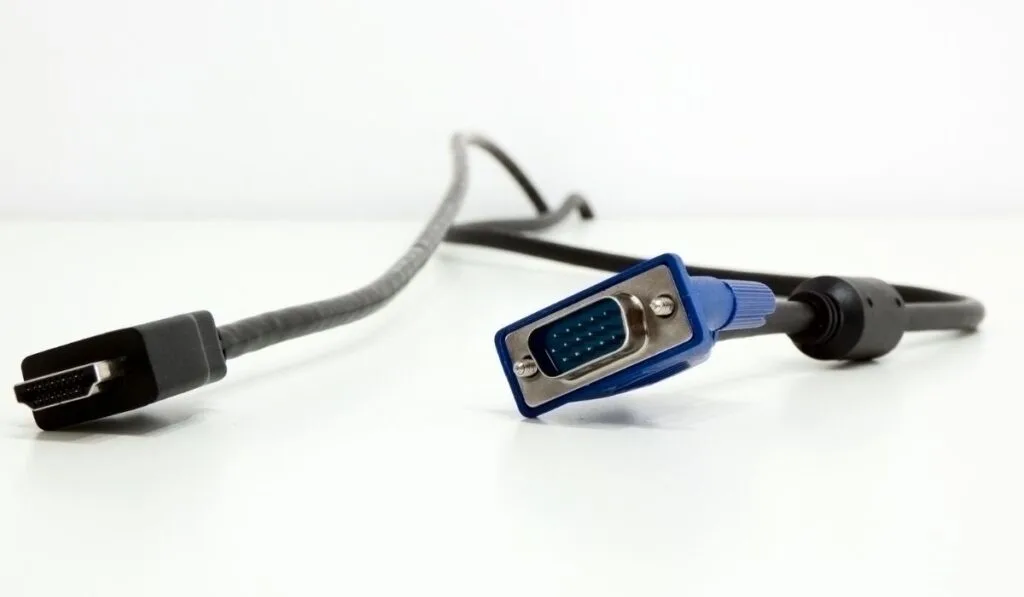Back in the ‘90s, Video Graphics Array (VGA) cable was the real deal. It was the standard video output for computers and laptops. A decade later, HDMI was introduced to upgrade VGA with better services. But what is a VGA cable?
VGA cable is a computer cable with a connector and a cable at each end and is used to connect computers to monitors and screens. Unfortunately, it’s relatively old and only transfers picture signals with resolutions of up to 640×480.
But VGA still has a mark in today’s market. Admittedly, it’s not the most practical device, but it is still in existence. So let’s take a closer look at the cable and how it compares to HDMI.
Why Do You Need a VGA Cable?

A VGA cable (on Amazon) is handy if you own older models of electronic devices, e.g., TV and laptops. This is because you can use it as a connector to send signals between computers, laptops, TVs, and monitors. However, most modern gadgets have HDMI inputs and not VGA.
In such a case, you’ll need an adapter cable to convert VGA to HDMI. While the process isn’t complicated, you have to get everything right to work out.
Is VGA Outdated?
VGA still has its uses today but is quickly being replaced by HDMI. This is because current electronic devices are thinner and lighter and feature display interfaces such as Thunderbolt and HDMI to connect computers to monitors and other devices.
A huge downside with VGA is it doesn’t transfer audio and requires a separate connection. This sounds like a joke considering current cables such as HDMI can transfer both. With this, VGA is slowly being phased out and is no longer as popular as it used to be.
You can still use it (it will work perfectly), provided the devices you use have the respective VGA ports.
Is it Better to Use VGA or HDMI?

Both HDMI and VGA cables connect devices such as DVD players and computers to displays like monitors, screens, and projectors. HDMI is the standard default cable for newer gadgets and electronic devices like LED TVs and Blu-Ray players.
HDMI cables (on Amazon) transmit both video and audio. In addition, they have a maximum refresh rate of 240 Hz and a maximum resolution of 1920×1200. The cables are compatible with most graphic cards.
On the other side are VGA cables. They only transfer video and have a maximum resolution of 640×480 (1600×1200 for UXGA). Here are a few comparisons between the two:
- Length doesn’t affect HDMI cables since they don’t have internal interference. On the other hand, VGA cables can have their signals degraded if the cable is very long. The signal quality is also subject to crosstalk.
- HDMI cables support both audio and video. Moreover, they are compatible with high resolutions, such as 4K and HD. VGA cables can only transfer video signals. You’ll need a different connection for the audio.
- VGA cable is inexpensive and readily available online and in electronics shops. Likewise, HDMI cables are affordable and can go for as low as $6. High-end products will, however, retail for as much as $100.
- VGA cables have a maximum resolution of 640×480. HDMI is way better and has a maximum resolution of 1920×1200.
One area where VGA outshines HDMI is the input lag. VGA cables have less input lag since the analog transmission is direct. However, HDMI cables must process the digital images before displaying them, leading to a delay in their response time.
HDMI cable is unarguably better than VGA in different aspects. It is faster, more efficient, and equally affordable. Plus, it transfers both audio and video. But, unfortunately, time has caught up with VGA, and it’s not as good or popular as it once was.
Looking at all these features, making a purchasing decision should be easy.
Time to Upgrade to HDMI
If you are among the few who still use VGA, it may be time to upgrade to HDMI. HDMI cables are cheap; you can find them for as low as $6. So, price shouldn’t be a hindrance. Also, newer electronic devices may not have VGA ports.
